This is a very long story about a valuable 1867 silver commemoration trowel used in the laying of the foundation stone of Torquay’s Haldon Pier, that was later used to weed a driveway, lost during late 1800’s, then found in the rubbish on Rainham Marshes by an Edwardian Chatham bricklayer, acquired by Torquay Town Council in 1910, placed in the Museum and then … lost and (at the time of writing) never seen again.
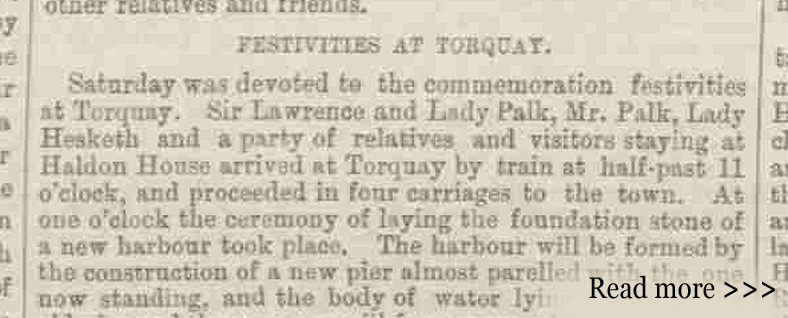
How did this silver trowel from South Devon end up in the rubbish at Rainham 43 years later?
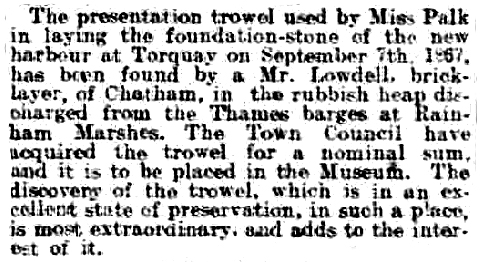

The trowel (part of Torquay’s history) was last seen in about 1910 if certain stories are to be believed. The fact that this trowel was allegedly seen and presumably picked up and kept means that it must be somewhere in the world, although hopefully in the United Kingdom at least.
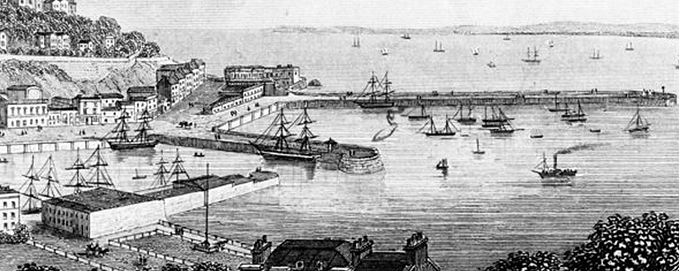
Quite often you can start out quite innocently looking for one piece to information only to discover a few lines of text written years ago that can lead you on a hunt for a completely different story.
This is exactly what happened with this seemingly uninteresting tale. I was following my friends research surrounding her own interesting family history in South Wales through newspapers filmed and supplied by the British Library. While she tediously searched each newspaper page for the slightest clue to her own research she came across this story about Torquay which she naturally passed on to me. At first it didn’t seem a particularly interesting story – just something about the trowel used to inaugurate Torquay’s Haldon Pier .
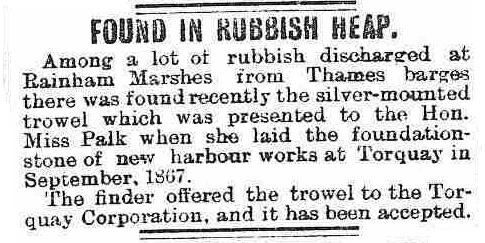
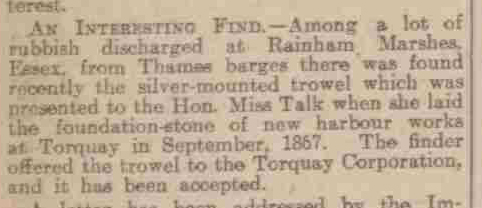
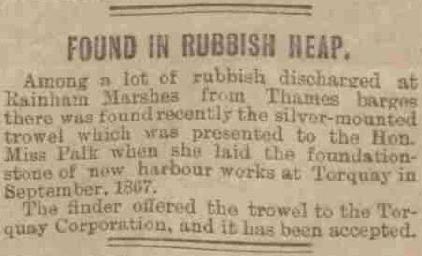
Such is my interest in this strange little story, I wrote a short piece for the local Torbay evening newspaper, The Herald Express. Much to my surprise I even had a published response which led to further research and historic investigation:
“Trowel came to sticky end”
‘I have some information concerning the “Haldon trowel dump mystery” brought to light by Ian Waugh.
The Hon. Miss Palk who originally laid the foundation stone of Haldon Pier in 1867, was a close friend of my great great aunt Mathilda who lived in Galmpton.
Apparently Miss Palk was given the trowel as a memento of the auspicious occasion.
Subsequently she lent it to a refugee from the American Civil War, a certain Clancy Washbourne III, who needed it to dig up some weeds on his driveway. Mr. Washbourne never returned it, in spite of being reminded several times.
Subsequently Mr. Washbourne moved to London and it is my guess that he took Miss Palk’s trowel with him.
Where is the trowel now ? We should be told!’
Perry Edgbaston, London
I was naturally somewhat surprised to read that this historical piece, which is of considerable Devonshire interest, should be used to weed a driveway and then found years later being dredged up at Rainham of all places. I would be fascinated to know why it was found in these circumstances, if anyone knows anything about this bizarre story, where the trowel is now and what became of Clancy Washbourne III. As the story received such national prominence in 1910, albeit short copy, my hunt for the missing trowel has been ongoing since 2000.
Needless to say that these things never run smoothly and to date I have found no trace of Clancy Washbourne III in any record either in the UK or the USA for the period 1850 – 1930 – interesting and informative as Mr. Edgbaston’s correspondence is to the Herald Express. Indeed I tried to make direct contact with Mr. Edgbaston to see if I could glean any further little detail, but to no avail. It appears that Clancy and Perry are quite a mystery in itself!
Meanwhile Thurrock Council and their Library in Grays took up the story and conducted a research to find any further reference to the original article and searched the archive of The Grays and Tilbury Gazzette and found no reference to the story.
The Chief Librarian for the London Borough of Havering, George H. Saddington, DMA, FLA, ACIS, MIMgt., also researched his archive. Although he found nothing he did suggest that “The Rainham area had been used for the disposal of mainly domestic waste from London since at least 1860, carried by barge down the Thames, so this would explain the appearance of the trowel on the marshes if Clancy Washbourne had moved to London”. Mr. Saddington went on to say that he had searched the census and death records for Clancy Washbourne III and found nothing. He suggested that Clancy might have returned back home to America.
Although the identity of this former American Civil War refugee is intriguing as is the content of Mr. Edgbaston’s open letter to the press, one thing is for sure, the trowel which Hon Miss Palk allegedly loaned to Clancy Washbourne, which was used to inaugurate Haldon Pier was last seen in Britain in 1910 – the question now, is where is it today?
Iain Fraser has written ‘Palk Family of Haldon & Torquay’ which is due to be published soon. Iain very kindly sent me these notes on 4th Baronet Palk:
Sir Lawrence Palk, 4th Baronet, 1st Lord Haldon
Lawrence Palk married Maria Harriet Hesketh, only daughter of Sir Thomas Hesketh Bt., of Rufford Hall, Lancashire in 1845. They had four sons and two daughters: Annette Maria Palk, married Sir Alexander Baird Bt. in 1873. They in turn had seven children and the eldest, John Lawrence, became the 1st Viscount Stonehaven and Governor-General of Australia in 1925. Unfortunately, Annette died quite young and after only eleven years of marriage.
The other daughter, Evelyn Elizabeth Palk married Major Ernest Gambier-Parry OBE, in 1882. Evelyn was the recipient of the prestigious Royal Red Cross Medal, awarded to those who had made a major contribution to nursing.
On 6th September 1867 celebrations were held to mark the twenty-first birthday of his eldest son Lawrence Hesketh Palk. To mark the event, Ellacombe Green was given as a gift from Sir Lawrence and his son, to the town to be used as a recreation ground. At the same time, his eldest daughter, Annette Maria was given the honour of laying the first foundation stone of the new pier, still known today as the Haldon Pier.
The Palks were then entertained by the residents of Torquay, at a banquet held in the Bath Saloon. Lawrence Hesketh was presented by the townsfolk with a silver epergne, costing over 160 guineas.
I have found from great experience that nothing is impossible when it comes to historic research.
The Western Times – Wednesday 02 February 1910 also reported the find and the fact that Torbay Corporation paid money to have it returned to the town, So, if that is the case where is it?
I contacted Torquay Museum in anticipation that at last this South Devon mystery was at long lost solved.
Barry Chandler, Curator of Collections at Torquay Museum, duly replied with the news that he had done a search of the data base and the accessions register from the period and could find no mention of this trowel ever entering the Museum. He told me “it does not seem to be here now on the database”.
15 years on and this historic researcher is now tearing his greying hair out.
If you know anything – no matter how seemingly trivial relating to this story or the people named here please feel free to contact me.




